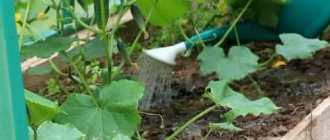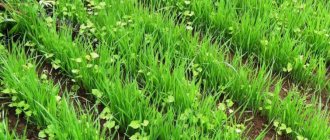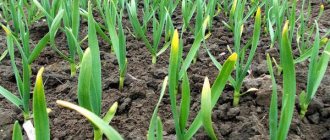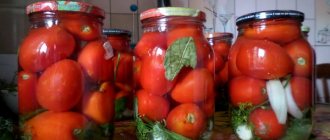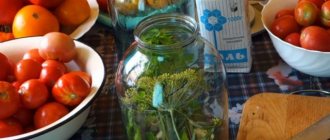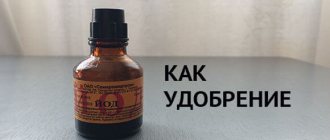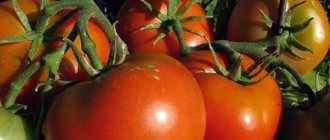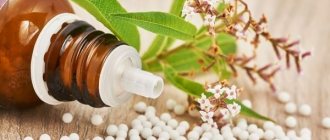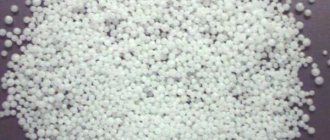It may seem to novice gardeners that it is impossible to grow a rich, much less an early harvest, without the use of chemicals. However, experienced vegetable growers have been collecting organic tomatoes from their beds and greenhouses for years. The secret of their success lies in the use of biologically active and safe substances, and in particular iodine.
Does spraying tomatoes with iodine help, how to prepare a solution for root and foliar treatment, what nuances should be taken into account when working with this product - you will learn all this from our article.
Benefits of iodine for tomatoes
The main property of an alcohol solution of iodine is instant disinfection. The product is often used to cauterize open wounds.
Gardeners have long used iodine as a fertilizer, but it has gained the greatest popularity among greenhouse owners. It is believed that this pharmaceutical product does not harm either the plant or people.
Iodine is an optional component for plant growth, but its lack has a negative effect on the development of ovaries and the formation of fruits. Young plants especially need this element.
Signs of iodine deficiency
Substance deficiency can be recognized by the following manifestations:
- plants have thin stems;
- leaves are weak and limp;
- adult plants do not enter the fruiting stage;
- a small number of ovaries;
- delayed fruit ripening;
- massive damage to seedlings by diseases - root rot, brown spot, late blight and tobacco mosaic virus.
If the deficiency of the element is not eliminated, plants begin to suffer from decreased immunity and, as a result, the development of various diseases caused by pathogens. The product serves as an additional fertilizing for the soil, helps accelerate the growth of seedlings and helps save the crop in case of disease.
The effect of iodine on seedlings
The active components of the element improve nitrogen metabolism, which makes it possible to fertilize seedlings without the use of nitrate. The pharmaceutical product is also known for its fungicidal properties: experienced summer residents use it both as a preventive measure for various diseases and to disinfect seeds before planting. It has been proven to help fight fungal and bacterial diseases of tomatoes.
Tomatoes actively react to aggressive iodine components. The effect of fertilizing and spraying is not long in coming - the plants begin to grow rapidly. In addition, the number of ovaries and fruits increases.
IODINE IS A SUPER MEANS FOR TOMATO SEEDLINGS!
What are the benefits of iodine for tomatoes?
Iodine for tomatoes growing in home beds is used in 2 ways: as a fertilizer from which plants can obtain this element and as a simple and affordable preventive and therapeutic agent used to prevent or combat fungal diseases. In the first case, an iodine solution is also used to improve nitrogen metabolism in the soil, thus providing some replacement for traditionally used nitrogen fertilizers such as nitrate.
The use of iodine as a fertilizer for tomatoes stimulates a faster onset of fruiting. Such fertilizing becomes especially effective in cases where it is necessary to induce the onset of fruiting in plants that should already bear fruit, but due to iodine deficiency in the soil this does not happen.
A lack of this element in the soil can also lead to a decrease in the overall yield of plants, or to the formation of small quantities of fruits on tomatoes, as well as to their late ripening. It has also been established that this element helps tomato fruits quickly acquire a bright red color, that is, it makes them more attractive and tastier, and also enhances their ability to withstand subsequent storage.
The benefit of iodine for tomato seedlings is that it helps them to take root after transplantation and takes part in many processes occurring in tomato plants, which means it will be very useful for the growth and proper development of young plants, just like adult tomatoes.
Cooking recipes and processing technology
When preparing an iodine-based spray solution, many vegetable growers use dairy products to enhance the effect. However, few people know that the aggressive components of the element destroy beneficial lactobacilli, so the benefit of adding whey and milk to the mixture is insignificant.
The only way dairy products help is that they envelop the plants, preventing the solution from being quickly washed out. Milk forms a fatty film on the green mass, which fixes the substance on the leaves.
It has also been noted that a mixture of iodine and Fitosporin, popular among gardeners, is ineffective.
How to dilute iodine so as not to burn the plant? Here are some popular recipes.
Folk remedy - milk with iodine
A solution of milk with iodine is used as a prevention and treatment of fungal diseases. Add 1 tbsp to 1 liter of warm water. milk and 5 drops of iodine. The mixture is suitable for treating the above-ground parts of the plant using a fine spray bottle. The procedure is carried out in the morning or evening, spraying all the tomato leaves.
Important ! To prepare the solution, use only low-fat milk.
Potassium permanganate with iodine and boric acid
For feeding, many summer residents use potassium permanganate, iodine and boric acid. These components provide disinfection, increase productivity and serve as protection against diseases.
Feeding is carried out in 3 stages with a break of 5-7 days:
- The bushes are treated with a solution of manganese - 4-5 g of the substance are diluted in 10 liters of water. The solution is used for spraying and watering at the root; 0.5 liters is enough for one bush.
- Make up with boron - dilute 0.5-1 tsp in 10 liters of water. facilities. The solution is used for spraying.
- Iodine treatment - 10 drops of alcohol solution per 5 liters of water. The leaves of the seedlings are carefully treated with the product.
Root feeding of tomatoes
It is important to choose the right time for root feeding. Seedlings especially need the element during the development period. The first iodine supplement is applied after the second pair of leaves appears on the plant. The soil is watered before the procedure.
Usually 1 liter of iodine supplement is enough for 1 plant. For low-growing varieties of tomatoes - 0.7 liters per bush.
Important ! Cold water should not be used to prepare solutions; it can chill the root system of plants.
Root feeding scheme:
- 10 days after planting the seedlings . You can use a simple solution - dissolve 1 drop of iodine in 3 liters of warm water. Fertilizer is applied at the root when the top layer of soil dries out a little.
- When plants become tasseled . The solution is prepared according to this recipe: for 10 liters of warm water you will need 3 drops of iodine.
- During the fruiting period. Add 500 g of wood ash to 10 liters of boiling water, cool the mixture, then dilute it with water 1 to 2. Add 5 ml of iodine and 8-10 g of boric acid to the solution. The resulting concentrate is infused for a day, and then diluted in a ratio of 1:10.
Application against pests
Weevils, aphids and chafer larvae are afraid of iodine. As a preventive measure, perennial plants are watered at the root with the following composition: 10-15 drops of alcoholic iodine solution per 10 liters of water. 1 liter is enough for one bush.
To combat aphids, you can use the following recipe: add 0.5 cubes of iodine to 100 ml of warm milk with a syringe, dilute the mixture with 1 liter of water. Spray the leaves of plants with the solution. Preparations containing iodine are also effective, for example, a 10% solution of Farmayod.
Disinfection of seeds before planting
Processing of seed material has long become a mandatory preventive measure. Previously, seeds were soaked in potassium permanganate, but practice has shown that iodine can also be used for disinfection. It protects, improves immunity and accelerates seed germination.
Recipe for seed treatment solution: dilute 1 drop of iodine in 1 liter of settled water. Do not increase the concentration of the product, otherwise it may burn the material. The seeds are soaked for 6-8 hours, then, without washing, they are dried and planted in a planting box.
Peculiarities of cucumber processing
Cucumbers, just like tomatoes, need fertilizing containing iodine. The microelement affects cucumbers as follows:
- the plant rejuvenates;
- leaves do not turn yellow;
- productivity increases;
- cultural growth increases.
Treatment is carried out at the beginning of flowering. Composition of the mixture: 10 liters of water, 10 ml of brilliant green, 2 liters of whey, a pinch of urea and a few drops of iodine. The following recipe will help you cope with late blight: 40 drops of iodine, 20 ml of peroxide, 1 liter of dairy product are diluted in 10 liters of warm water.
Treatment of cucumbers for preventive purposes helps to increase productivity. Lactose, which is part of dairy products, prevents pests from multiplying, nourishes the plant and enriches the soil with valuable substances. The only drawback is that if the cucumbers are already affected by pests, then such treatment will not help and other means must be used.
How to properly process tomatoes
Iodine is used for both root and foliar feeding; they are equally effective. Experienced gardeners alternate types of treatments to achieve maximum results. Iodine-based fertilizers are usually applied during watering.
Basic rules for watering tomatoes:
- after transplantation, do not water the seedlings for one week;
- It is not recommended to water the beds in cool weather, as this promotes the development of fungal infections;
- water only at the roots, avoiding moisture getting on the leaves of the plant;
- It is preferable to water in the morning or evening;
- use warm water.
Feeding with iodine is done twice a month. It is best to postpone the procedure until the onset of cloudy weather with an air temperature of more than +16...+18 °C.
How to spray seedlings with iodine? During the procedure, be careful - do not spray the solution in large drops, it is better to make the spraying misty. You cannot increase the concentration of iodine, otherwise it can lead to burns of the leaves.
Important ! Excessive treatment with iodine leads to deformation of the brushes and fruits.
Methods of fertilizing
Vegetable crops are processed by root and foliar methods. At the beginning of the growing season, the best option is to alternate both methods. This will be a good prevention of diseases, and if a disease occurs, after treatment the plant will quickly cope with it.
Root method of applying fertilizer
If you work with a product such as iodine, then it is very important to start processing the crop in a timely manner.
The very first fertilizing for tomatoes should be carried out only after the leaves appear on the seedlings. Only wet soil can be treated with the solution. Using this method of fertilization, you can see the result from the first application.
Foliar method
This method is carried out by spraying. A spray bottle is best for this, because it is necessary for the composition to disperse into small particles. Spraying is carried out along the entire perimeter of the bush, avoiding excessive application of the composition to the leaves.
It is worth considering that with this method it is necessary to adhere to all proportions of the ingredients in order to prevent burns from occurring on the leaves.
When caring for tomatoes, you should use two feeding methods. At the beginning of the bush’s maturation, they should be alternated, and then only the root method should be used.
Leaves are treated only if the plant is sick.
Regular treatment of tomatoes with iodine solution will provide reliable protection to the plant, which will further contribute to a good harvest.
How to use outdoors
There are several nuances in using iodine:
- the product is measured with a pipette;
- for solutions use water without chlorine;
- the temperature of the water for spraying should not be lower than +25 °C;
- processing is carried out in calm weather;
- When fruit sets, feeding with iodine is stopped;
- Before the first treatment, the soil is pre-watered with a solution with a weak concentration of iodine.
Important ! Fertilizing should not get on the root collar of the tomato.
How to use in a greenhouse
Iodine is used to disinfect soil and greenhouse structures. Typically, treatment is carried out twice a year - after harvesting and before planting seedlings. Prevention against infectious agents can begin when the air warms up to +10 °C.
Important ! Disinfection of the greenhouse with iodine is carried out in a respirator and safety glasses, opening all the windows and doors.
For disinfection, you can use the drug “Farmayod” - for 10 liters of water you will need 10 ml of the product. For 10 sq. m, 1 to 3 liters of solution is enough, depending on the diseases in the previous season. This solution can also be used to treat the soil before planting. If tomatoes suffered from late blight last season, the concentration of the drug is increased to 30 ml.
Iodine treatment in a greenhouse not only destroys late blight, but also reduces the number of thrips, nematodes and mites.
Precautions during operation
The following recommendations for working with solutions must be taken into account:
- Processing in open ground is carried out without special protective equipment.
- In a greenhouse or other enclosed space, working with a concentrated solution requires respiratory protection due to the volatility of the drug.
- Treatment is not carried out on plants planted in the ground less than 10 days ago.
Using iodine as a protectant for tomatoes is a proven and safe method. Timely prevention can increase plant immunity and reduce the degree of late blight damage.
Spraying timing
Experienced summer residents spray the beds for the new month. During this period, the green mass absorbs nutrients as much as possible.
The first spraying is carried out 2 weeks after planting the seedlings. The procedure is especially necessary in the first phase of tomato growth; as a rule, it falls in July. Then you can spray the plants once every 15 days.
Some gardeners treat seedlings with iodine before planting. For 10 liters of water you will need 1 liter of milk and 15 drops of iodine.
The treatment is carried out on a cloudy day or in the evening in calm weather. Practice has shown that beneficial substances are better absorbed in the morning. If you carry out the procedure after sunset, the product may be washed away by night dew. The optimal temperature for the procedure is +18 °C.
It is also worth paying attention to the weather in the days following treatment. If there is rain in the forecast, it is better to postpone the procedure until next time. Precipitation will wash away the milk film, so the benefit of spraying will be reduced to zero.
Combination of foliar fertilizing with late blight treatment
Treatment with a solution containing iodine will not only saturate the plants with the necessary components, but also protect them from late blight . To prevent the disease, use the usual recipe for spraying with milk.
You can spray the plants daily if you increase the concentration of dairy products. For 1 liter of water you will need 1 liter of milk or whey. This solution will increase the growth of tomatoes and provide them with nutrition.
In the fight against late blight, a solution of iodine and milk is used for a month, with intervals between treatments of 3 days. For preventive purposes, you can spray the beds once a quarter.
Root feeding with solutions containing iodine
Feeding with this element can be combined with the addition of other nutrients in liquid form, adding three to ten drops of 5% iodine tincture to the nutrient solution for every ten liters. The number of drops increases as the tomatoes themselves grow. This is root feeding. It is carried out no more often than once every fifteen days. During the gardening season, you can carry out up to four such feedings. Five liters of solution are consumed for every square meter. Water the plants at the roots, wetting the soil around them. With this treatment of tomatoes with iodine, pathogenic fungi located on the surface of the soil are destroyed.
Useful tips
Iodine has been used in the garden since Soviet times. During this time, gardeners figured out how to enhance its effect and during what period it should not be used:
- You can enhance the effect of the substance by preparing a solution based on it with the addition of 8-10 g of superphosphate and 15-20 g of potassium salt . This type of feeding is considered comprehensive. Its consumption will be significantly lower - instead of 1 liter, you can pour 400-500 ml under the bush.
- The product stimulates the flowering of tomatoes . During this period, you can prepare a spray solution using iodine, boric acid, urea and humate.
- You cannot use an iodine solution if less than 10 days have passed since the seedlings were planted.
- If iodine is used in plant nutrition, there is no need to add pharmaceutical preparations “Trichopol” and “Aspirin” to the treatment solution .
- Treatment with iodine can be alternated with boric acid and hydrogen peroxide . These products should be used 4 days after iodine supplementation.
Reviews from vegetable growers
The opinions of experienced summer residents regarding the use of iodine are ambiguous - many are satisfied with this supplement, but there are also those who have had negative experiences with this pharmaceutical product.
Opponents of iodine claim that it does not have a pronounced effect. And its use in the treatment of diseases can lead to an advanced form of the disease, when no chemical preparations can save the plant.
Anna, 52 years old: “I use fertilizing with iodine a week after planting. I try to choose a time when the soil dries out a little - this way the plant receives not only iodine, but also water.”
Dmitry, 65 years old: “I noticed that one treatment with iodine is enough to protect plants from fungal and bacterial diseases. Spraying with iodine is a good means of prevention.”
Svetlana, 73 years old: “I’ve been using iodine for many years. This cheap pharmaceutical product increases the yield by 10%, and the tomatoes themselves turn out large and juicy.”
